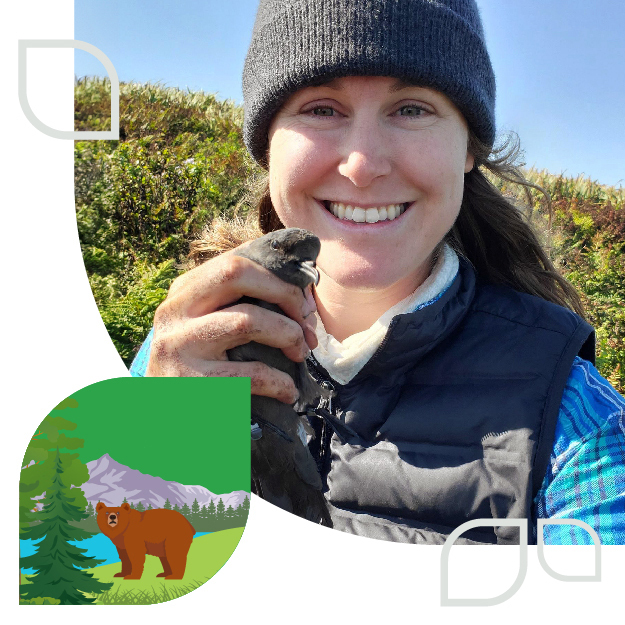Spotlight on science: Informing and mobilizing: essential actions in science - Bronwyn Harkness
Profile of Bronwyn Harkness
Informing and mobilizing: essential actions in science

Bronwyn fell in love with birds at the age of eleven, on a family camping trip, when she picked up her first identification guide and became aware of the ubiquity of winged fauna. Although she did not know whether she would ever be able to make a living from it, science was beginning to play a significant role in her life.
A decade later, science was at the heart of her academic activities. As a student in the Department of Biology at Queen’s University, she spent three years studying genomics of seabird species, including the genomic structure of guillemot populations, and the genetics of band-rumped storm petrels.
It was in this context that she made her first contact with ECCC scientists in Newfoundland. “I met the nicest people there! I’m grateful for their patience and kindness, and for the many answers they gave me and the knowledge they shared about fieldwork and seabirds,” recounts Bronwyn in a journal she kept at the time. She officially joined ECCC in 2018. At the time, she was convinced that she wanted to dedicate herself to science, and she headed off to the Arctic to begin her mandate.
Making science accessible
After a field season in the North, Bronwyn spent time as a research coordinator and almost a year as an acting manager for the Wildlife Research team before finally transitioning to her current position as coordinator of the science end-user engagement portion of the Genomic Adaptation and Resilience to Climate Change (GenARCC) project.
GenARCC was launched in April 2022 and will run for five years. This collaborative initiative brings together over 150 scientists from eight government departments and multiple collaborators across Canada. Their objective is to assess the vulnerability of key Canadian species to climate change using genomic tools, and to inform climate change adaptation to help protect Canada’s biodiversity, ecosystem resilience, food security, and health. “My role in the GenARCC project is to produce tools and products to make genomics accessible, to support scientists in sharing their results, and to share the benefits of a project like this for the Canadian public,” explains Bronwyn.
Although her work description is clear and specific, the challenge is nonetheless complex! “Scientists are studying a huge number of species, from polar bears to microbes, in an impressive diversity of Canadian ecosystems, and we want to communicate the results of this research to a very wide range of audiences. My challenge is identifying the message, choosing the right format to convey the information, and picking the right moment to communicate information about our project.”
Knowledge and learning
Bronwyn’s experience in her academic environment has given her solid expertise in genetics and genomics, which gives her a clear advantage in her position. She knows how to explain complex jargon in accessible language. She also has what it takes to steer a project involving many components, which requires substantial logistics to coordinate.
Bronwyn also focuses a great deal on learning, an aspect of her work that drives her. “I’ve learnt a lot about best practices for communicating science to different audiences. As part of this, we have a strong focus on engaging with the Indigenous peoples that we work with in a respectful and ethical way. In my experience, face-to-face meetings are an important part of reaching the people involved in a project.” She shares this learning with the GenARCC community, for whom she facilitates training on the transmission of scientific results and Indigenous engagement.
Believing in the value of our work
Bronwyn freely admits that she feared she would find it difficult to have to immerse herself every day in matters relating to climate change and the impacts on biodiversity. Today, however, she can safely say that the challenge has been positive in every respect: “It’s very stimulating to be part of a project that has meaning and that has value for our future. I feel like I’m doing the right thing, and that I’m where I need to be. I believe in the importance of the work we’re doing with GenARCC, and I can only hope that we can make a difference to the crisis we’re facing,” says Bronwyn philosophically.
Another reason she values her actions is that she allows scientists to concentrate on the primary aspect of their work, research, while she works to give visibility to their work. “Researchers publish scientific papers and give presentations, but supporting them by communicating their findings more widely adds visibility to what they do and increases their chances of being heard. This maximizes the usefulness of science,” explains Bronwyn. The coming year will be an important turning point in the evolution of GenARCC, as more results will be made available and priorities will be about creating strong connections with policy and decision makers. Overall, Bronwyn will continue to work to make science accessible to guide decision-making in relation to ecosystem conservation and climate change adaptation policies.